Cosmopolitan Butterfly, Vanessa cardui
The Painted Lady butterfly (Vanessa cardui) is one of the most widespread butterfly species found on every continent except Australia and Antarctica. It is particularly known for its striking patterned wings, featuring a beautiful mosaic of orange, black, and white.
These medium-sized butterflies are renowned for their long migratory flights, with some populations migrating from North Africa to the Arctic Circle in Europe and Asia, and from Mexico to Canada in North America.
Painted Lady butterflies (Vanessa cardui) are cosmopolitan in their distribution and are found on every continent except Antarctica. Here’s a regional breakdown:
North America: They are widespread across the United States and Canada, especially in the spring and summer. They can often be found in open fields, meadows, and gardens.
Europe: Found throughout Europe, including the British Isles. Their numbers in any given year can fluctuate widely.
Asia: Present across Asia, with migration patterns that can take them into northern regions during warmer months.
Africa: Common in North Africa and, due to their migratory nature, they can be seen virtually all over the continent at different times of the year.
Middle East: They are a familiar sight and often occur in large migratory swarms.
Oceania: While not native to Australia, they are sometimes observed in New Zealand, where they are believed to be occasional migrants.
Because of their migratory nature and the wide range of their host plants, they are not just common but also among the most resilient butterfly species. They can be seen in both rural and urban settings as long as flowering plants are available for nectar.
The Painted Lady butterfly is a vibrant and highly mobile species recognized by its orange-brown wings with black and white spots.
These butterflies are admired for their striking patterns and are a favorite among both enthusiasts and casual observers alike.
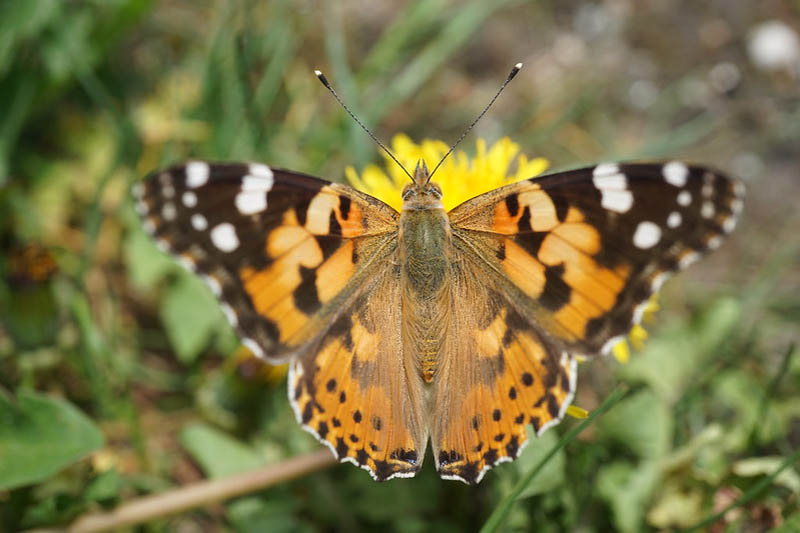
Painted Lady butterflies engage in a unique courtship ritual that is both intricate and fascinating. Here’s a brief description:
Initial Attraction: Males patrol and use their keen vision to spot potential mates.
Pursuit: Once a male locates a female, he engages in an aerial pursuit. If the female is receptive, she will allow the male to catch up; otherwise, she will fly away or engage in evasive maneuvers.
Aerial Dance: When a female is interested, she and the male will dance in the air, circling each other and flying in tandem.
Landing and Mating: Eventually, the pair will land. The male will approach the female from behind, and copulation occurs, often lasting for several hours.
Pheromones: Chemical cues or pheromones play a significant role during courtship, helping the male identify the female’s readiness for mating.
Repetition: After mating, females will lay fertilized eggs, and the cycle will begin anew. Males may mate with several females during their lifespan.
These butterflies are not territorial; males do not defend specific areas but instead roam widely in search of females. The courtship and mating processes are vital for the species’ survival, particularly as Painted Ladies are migratory and must ensure they reproduce before they die or undertake long journeys.
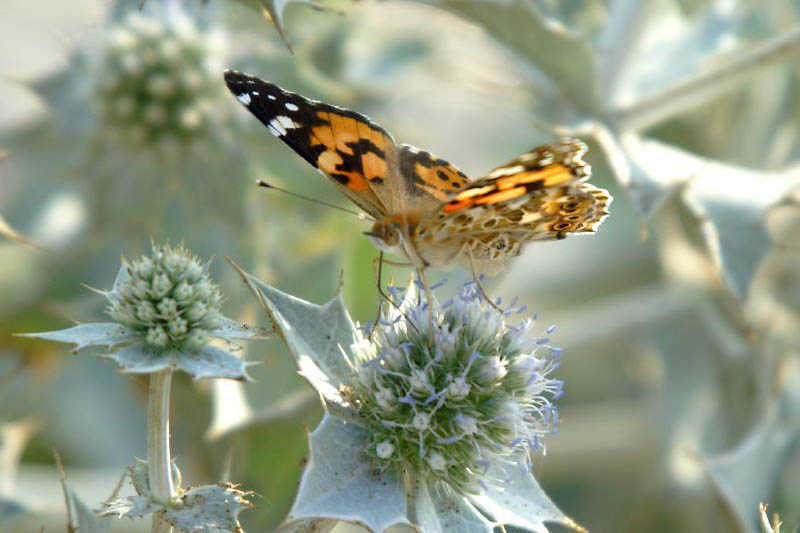
The Painted Lady butterfly has a fascinating life cycle that spans through four main stages:
Egg: The life cycle begins when a female lays her eggs on a host plant. The eggs are small, greenish, and barrel-shaped, usually laid on the underside of leaves to protect them from predators and extreme weather.
Larva (Caterpillar): Upon hatching, the larvae emerge as caterpillars. Painted Lady caterpillars are black with spiky bristles and yellowish stripes or spots. They feed voraciously on the host plants, growing rapidly and shedding their skin several times (molting) as they outgrow it. They go through 5 instars before pupating on the host plant.
Pupa (Chrysalis): After reaching a certain size, the caterpillar forms a chrysalis. During this pupal stage, the caterpillar undergoes a remarkable transformation called metamorphosis. The chrysalis of the Painted Lady is usually suspended from the underside of a leaf or stem and is a mottled blend of browns and grays for camouflage.
Adult Butterfly: Finally, the adult butterfly emerges from the chrysalis with wet and wrinkled wings. After resting for a short period, the butterfly will pump hemolymph (blood) into its wings to expand and dry them. Once the wings are fully expanded and dry, the butterfly can take flight.
This cycle can take about a month in warm weather. Painted Ladies can have several generations in a year, especially in warmer climates. They are known for their long migrations, which means they can have different broods in varying regions as they travel.
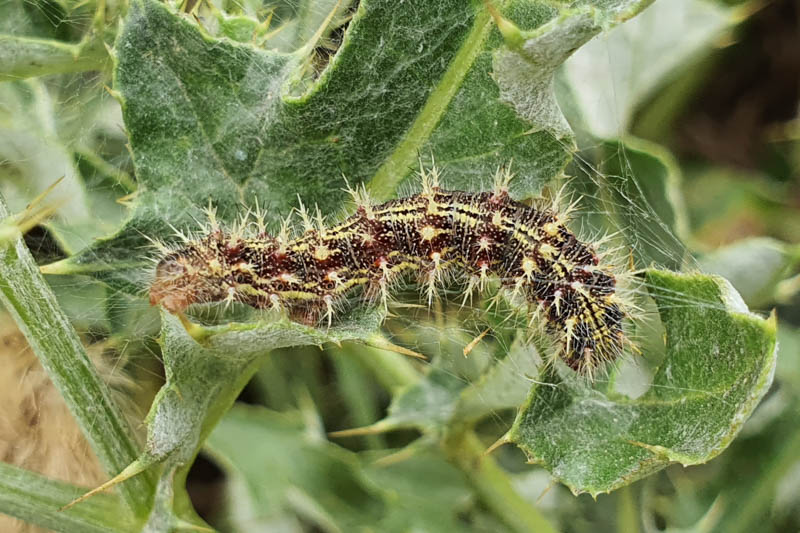
The painted Lady Caterpillar
The diet of the Painted Lady butterfly varies depending on its life stage:
Adult Butterfly: Painted Lady butterflies primarily feed on nectar from a variety of flowering plants. They are generalist feeders known to visit over 100 different kinds of plants, making them important pollinators. However, they prefer nectar from flowers of plants in the Family Asteraceae (Aster Family) that are 3-6 feet high (90-180 cm). Some of their preferred nectar sources include:
Caterpillar (Larva): As caterpillars, Painted Lady larvae feed on a different diet. They prefer a range of host plants, often favoring thistles, mallow, hollyhock, aster, and various legumes. They will eat the leaves of these plants, and as they grow, they can consume large quantities of foliage before pupating. The selection of host plants for egg-laying and larval feeding is crucial as it provides the necessary nutrients for the caterpillars to grow and eventually metamorphose into adult butterflies.
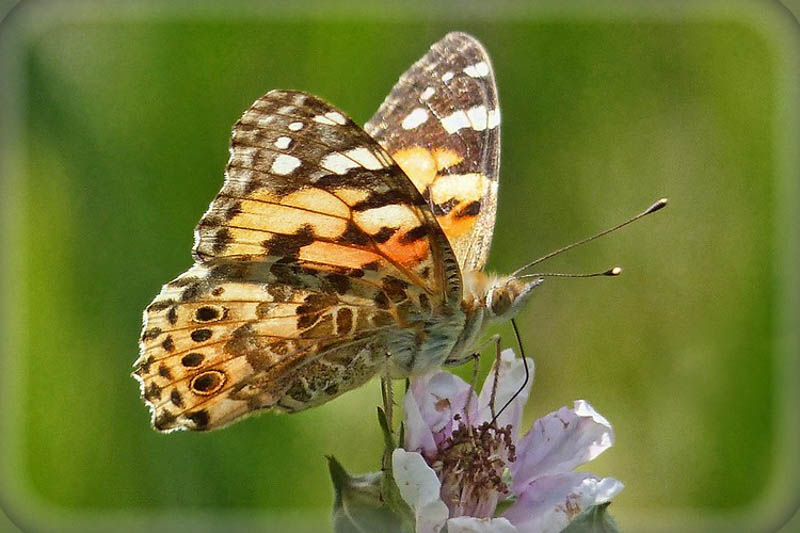
The Painted Lady butterfly is renowned for its remarkable migratory behavior. Here are some key points regarding its flight and migration:
This ability to migrate over long distances makes the Painted Lady butterfly one of the most prolific butterfly species, able to adapt to various ecosystems and climates. The exact mechanisms of how they navigate and the full extent of their migratory routes are still subjects of scientific research.
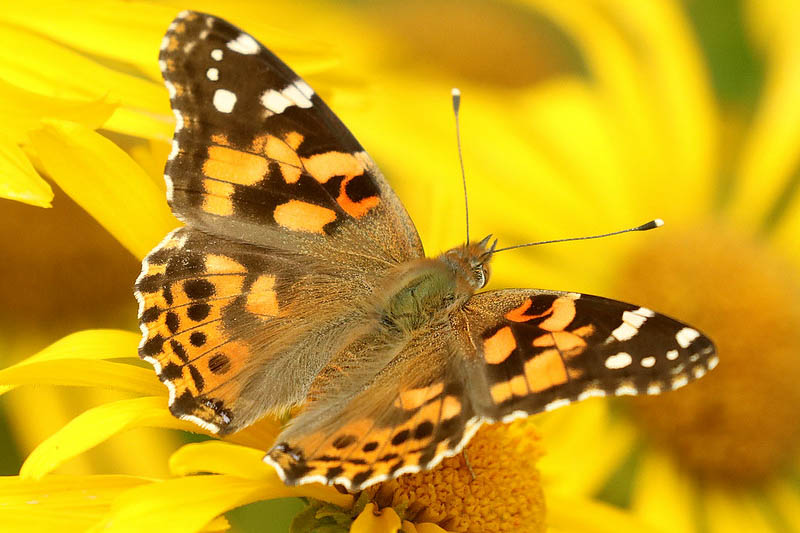
Painted Lady butterflies, like many other butterfly species, have a variety of predators at different stages of their life cycle. Here are some of the common predators they face:
Birds: Many bird species prey on adult butterflies, especially insectivorous birds that can catch them in flight or when they are resting.
Spiders: Spiders can capture butterflies in their webs or ambush them when they come to rest or feed.
Wasps: Some wasp species are known to hunt caterpillars, which they may use as food for their own larvae.
Mantises: Praying mantises are adept at catching various insects, including butterflies, with their powerful forelegs.
Ants: Ants can attack and consume butterfly eggs, caterpillars, and sometimes even chrysalises.
Rodents: Small rodents may consume pupae (chrysalides) or even adult butterflies if they can catch them.
The Painted Lady butterfly employs several defense mechanisms to protect itself from predators:
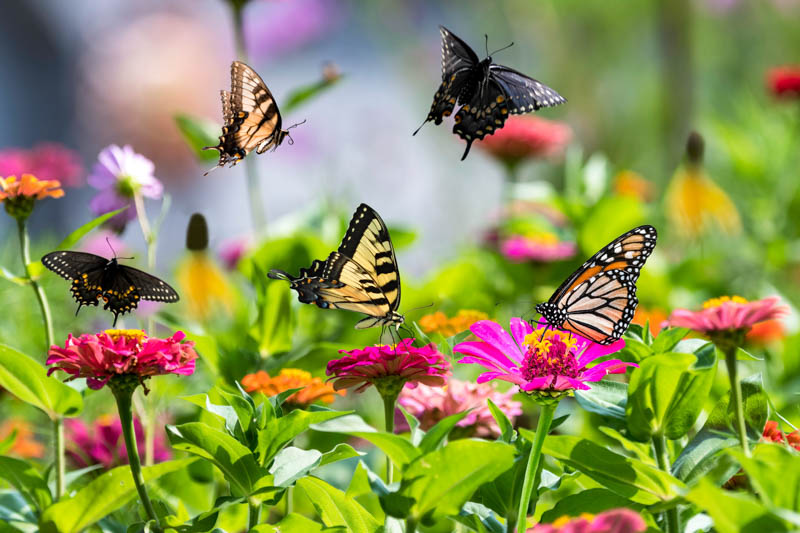
Attracting Painted Lady butterflies involves creating an environment that provides for their needs throughout their lifecycle – from caterpillar to adult. Here’s how you can make your garden inviting for them:
Plant Host Plants for Caterpillars: Include thistle, hollyhock, mallow, and other host plants that Painted Lady caterpillars feed on.
Grow Nectar Plants: Adult Painted Ladies feed on a variety of flowers. Grow a variety of nectar-rich flowers that bloom at different times throughout the season to provide a continuous food source. Flowers like cosmos, zinnias, asters, and Joe-Pye weed are excellent choices.
Provide Sun and Shelter: Butterflies generally need sunny open areas to bask and raise their body temperature, but they also need shelter from strong winds. Include some flat stones in sunny spots for them to warm up on, and plant some shrubs or trees for windbreaks and roosting spots.
Avoid Pesticides: Pesticides can kill caterpillars and adult butterflies. Use organic methods of pest control and tolerate a little bit of plant damage from the caterpillars you’re trying to attract.
Offer Water Sources: Butterflies need water but can’t drink from open water. Instead, they sip from moist soil and sand. Provide a shallow dish with damp sand or mud, sometimes called a butterfly “puddling” area, for them to drink from and absorb minerals.
Leave Some Wild Spaces: Having areas of your garden that are a little wild can provide additional resources for caterpillars and butterflies, such as additional host plants and hiding spots.
Garden Layout: Consider the layout of your garden. Planting in groups rather than singly can help butterflies conserve energy as they collect nectar.
Use Butterfly Houses: While not all butterfly species will use them, having a butterfly house provides a potential shelter for the insects during inclement weather.
By providing for their basic needs and considering their lifecycle, you can enjoy the beauty of Painted Lady butterflies in your garden while contributing to the preservation of the species.
Create a membership account to save your garden designs and to view them on any device.
Becoming a contributing member of Gardenia is easy and can be done in just a few minutes. If you provide us with your name, email address and the payment of a modest $25 annual membership fee, you will become a full member, enabling you to design and save up to 25 of your garden design ideas.
Join now and start creating your dream garden!
Create a membership account to save your garden designs and to view them on any device.
Becoming a contributing member of Gardenia is easy and can be done in just a few minutes. If you provide us with your name, email address and the payment of a modest $25 annual membership fee, you will become a full member, enabling you to design and save up to 25 of your garden design ideas.
Join now and start creating your dream garden!